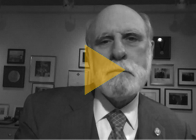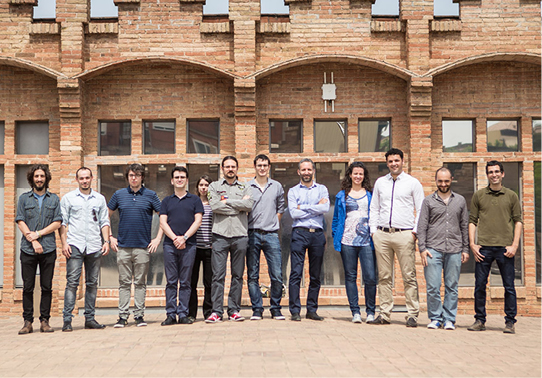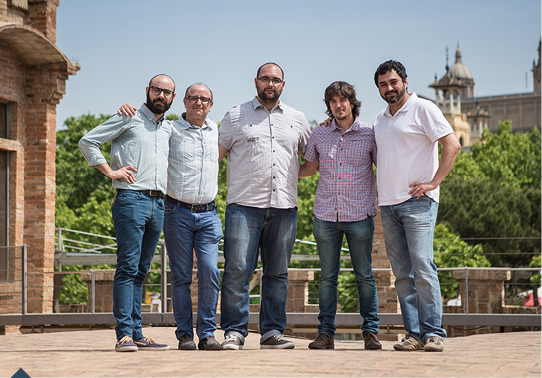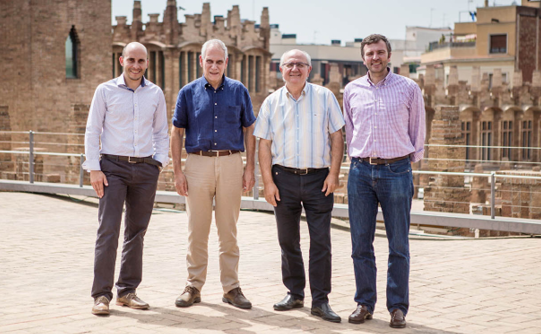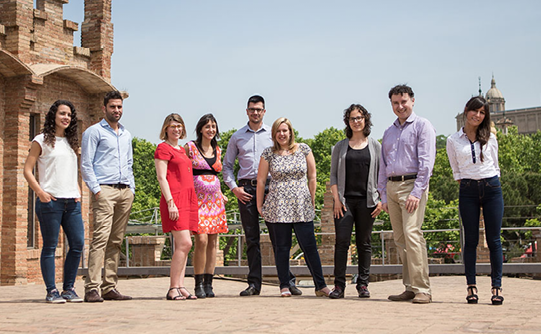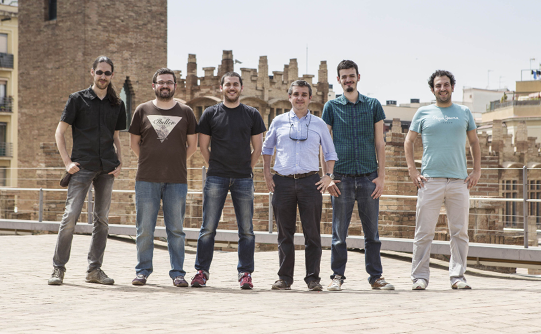FACTS & FIGURES
PROJECTS
CONTENT
Type of funding: EU- FP7 / Duration: 2012 - 2015
Description: Define a novel convergent network architecture supporting technologies in wired and wireless network domains.
DOLFIN
Type of funding: EU - FP7 - SmartCities / Duration: 2013 - 2016
Description: Design and implement a control framework for the management of energy efficient data centres.
SODALES
Type of funding: EU- FP7 / Duration: 2012 - 2015
Description: Define and develop a converged optical/wireless accesnetwork architecture that increases the spectrum utilisationefficiency and supports carrier-grade Ethernet services.
XIFI
Type of funding: EU - FP7 - SmartCities / Duration: 2013 - 2015
Description: Establishment of a sustainable market for testing Future Internet infrastructures and services.
OFERTIE
Type of funding: EU - FP7 / Duration: 2012 - 2014
Description: Use SLA-based management of cloud hosting across multiple data-centres over OpenFlow networks for ROIA applications.
OFERTIE
Type of funding: EU - FP7 / Duration: 2012 - 2014
Description: Use SLA-based management of cloud hosting across multiple data-centres over OpenFlow networks for ROIA applications.
CHARISMA
Type of funding: EU – H2020 / Duration: -
Description: Intelligent hierarchical routing and paravirtualised architecture that unites two important concepts: devolved offload with shortest path nearest to end-users and an end-to-end security service chain via virtualized open access physical layer security (PLS).
ONOFRE
Type of funding: Proyectos I+D Mineco / Duration: 2014-2017
Description: A access/metro network convergent design, with special focus on the effects of NGPON2 and NGPON3 evolutions. ONOFRE endorses open-source software in key aspects of the project: uses Net2Plan, an open-source network planning tool and public repository developed by UPCT, for algorithm prototyping, network planning and techno-economic analysis support, and Mininet Emulator, an open-source network emulator, for OpenFlow experiments.
CYCLONE
Type of funding: EU - H2020 / Duration: 2014-2017
Description: Targets the ASPs, providing them with software and tools that 1) facilitate the deployment, management, and use of their complex, multicloud applications and 2) enhance the end-to-end security and network management of those applications.
T-NOVA
Type of funding: EU – FP7 / Duration: 2014-2016
Description: With the aim of promoting the NFV concept, T-NOVA introduces a novel enabling framework, allowing operators not only to deploy virtualized Network Functions (NFs) for their own needs, but also to offer them to their customers, as value-added services. Virtual network appliances (gateways, proxies, firewalls, transcoders, analyzers etc.) can be provided on-demand as-a-Service, eliminating the need to acquire, install and maintain specialized hardware at customers’ premises.
IRATI
Type of funding: EU – FP7 / Duration: 2013-2014
Description: Implementation of a clean-slate architecture for the Linux kernel, over two of the most currently used technologies: TCP/UDP/IP and Ethernet. Improvement and contribution to the RINA specifications, specially in the fields of routing, policies for the discovering of applications and interoperability with Ethernet.
IRINA
Type of funding: GEANT3+ Open call / Duration: 2012-2015
Description: IRINA shall compare RINA against current networking state of the art and relevant clean-slate architecture under research; perform a use-case study of how RINA could be better used in NREN scenarios; and showcase a laboratory trial of the study.
FED4FIRE
Type of funding: EU - FP7 / Duration: 2012 - 2016
Description: Provide a federation of FIRE experimentation facilities, developing and implementing a federation architecture
FELIX
Type of funding: EU - FP7 Europe and Japan / Duration: 2013 - 2016
Description: Create a common framework for Future Internet (FI) experimental research into networks and distributed applications, in the EU and Japan.
FIBRE-EU
Type of funding: EU - FP7 Europe and Brazil / Duration: 2011 - 2014
Description: Build and operate an EU-Brazil Future Internet testbed based on OpenFlow and Wireless technologies (www. fibre-eu.eu/).
MINERVA
Type of funding: EU - FP7 Open Call GN3+ / Duration: 2013 - 2015
Description: Deployment of a robust network coding architecture in the GÉANT OpenFlow facility, which provides a highly available backbone network infrastructure for Future Internet applications.
GN3+
Type of funding: EU - FP7 - Infrastructures / Duration: 2013 - 2015
Description: Pan-European multi-gigabit network and associated services.
AAPD
Type of funding: EU - FP7 / Duration: 2013 - 2014
Description: Apply a refined prototype of the available platform in order to meet the requirements of the predictive analysis of a specific domain.
Help4Mood
Type of funding: FP7- ICT / Duration: 2010 - 2014
Description: Support for the treatment of major depression by measuring daily activity and mood.
Cirugia Bariatrica
Type of funding: MINECO - INNPACTO / Duration: 2011 - 2015
Description: The goal of the project is to implement a Virtual Reality Platform in order to support physicians during the Bariatric Surgery process and predict the results of surgery.
GTRS
Type of funding: Private / Duration: 2012 - 2014
Description: Physical rehabilitation exercises and decision support systems using Kinect.
CANAL DEL PACIENT
Type of funding: Private / Duration: 2013 - 2015
Description: Development of an online tool for medical assistance and communication between health professionals and patients.
AtlantisCare
Type of funding: MED Program Project WIDER Open Call / Duration: 2014
Description: Intelligent system to support care of older adults during ageing process.
MORE
Type of funding: Ajuntament de Barcelona / Duration: 2014
Description: eHealth remote platfomr for users with reduced mobility
Fearless
Type of funding: EU - AAL / Duration: 2011 - 2014
Description: Design a system able to detect a wide range of risks with a single sensor unit, enhancing mobility and enabling the elderly to take an active part in the self-service society by reducing their fears.
COM’ON
Type of funding: EU - AAL / Duration: 2012 - 2014
Description: As a result of the ethnographic research, the COM’PANION concept has been developed which empowers older adults to take on journeys of their own, through motivational feedback about e.g. distance and frequency of journey, as well as appropriate and timely support from a personal or professional peer.
CarismaTIC
Type of funding: Private / Duration: 2012 - 2014
Description: Tracking and monitoring of chronic patients using a tablet device.
GTRS
Type of funding: Private / Duration: 2012 - 2014
Description: Physical rehabilitation exercises and decision support systems using Kinect.
i2Health Sant Pau
Type of funding: MINETUR - AVANZA / Duration: 2011 - 2016
Description: The project explores the great potential of next generation networks and mobile devices in the Connected TV market, which is a strong focus of interest for the media industry.
TV-Ring
Type of funding: EU-CIP - PILOT B / Duration: 2013- 2016
Description: The project explores the great potential of next generation networks and mobile devices in the Connected TV market, which is a strong focus of interest for the media industry.
MITSU
Type of funding: CELTIC PLUS - Private / Duration: 2013- 2014
Description: The MITSU project develops the next generation of multimedia streaming systems to be used over wireless networks.
NOTTS
Type of funding: CELTIC PLUS - Private / Duration: 2013- 2015
Description: NOTTS investigates the technical problems experienced by service providers of over-the-top multimedia services, proposes realistic solutions, and evaluates these solutions on testbeds and real networks.
Visionair
Type of funding: EU-FP7 Capacities / Duration: 2011- 2015
Description: The project’s aim is to create a European infrastructure that should be a unique, visible and attractive entry towards high level visualisation facilities. These facilities must be open to access by a wide set of research communities across Europe and around the world.
Networked Production
Type of funding: MINECOINNPACTO / Duration: 2011- 2014
Description: The project aims to evolve the networked production of the audiovisual chain of television and audiovisual content producers.
I AMn
Type of funding: ENPI-CBCMED / Duration: 2012- 2015
Description: The I AM project aims to cooperate in and develop applications to enhance the visitors’ experience of natural and cultural heritage sites. It focuses on the use of Augmented Reality (AR), multimedia and interactive techniques.
Terrassa +
Type of funding: Private / Duration: 2013- 2014
Description: Terrassa Augmentada is aimed at delivering and enhancing an educative guide of the Modernism period in Terrassa, using mobile and mixed reality technologies to offer a new and engaging experience.
SPECIFI
Type of funding: EU -CIP Pilot Actions / Duration: 2013- 2015
Description: SPECIFI combines NGA and IoT infrastructures and platforms for setting up a European Creative Ring of Smart Cities and Regions facilitating the set-up, customisation, delivery and sharing of innovative, user co-designed arts, media and leisure services locally, regionally, and across Europe.
FI-Content 2
Type of funding: EU - FP7 Capacities2 / Duration: 2013- 2015
Description: The project is aimed at developing and experimenting cutting edge ICT platforms across Europe devoted to applications and services in the areas of social connected TV, smartcity services, and pervasive games. The project is offered to any European stakeholder, specifically aimed at developers and SMEs access to use these open platforms.
RICHES
Type of funding: EU - FP7 SSH / Duration: 2013- 2016
Description: The RICHES project researches the context of change in which European Cultural Heritage is transmitted, its implications for future CH practices, and the cultural, legal, financial, educational, and technical frameworks to be put in place for the benefit of all audiences and communities in the digital age.
AthenaPlus
Type of funding: EU- CIP / Duration: 2013- 2015
Description: Athena Plus is a project which aims to contribute large amounts of content to Europeana, to improve the search and use of Europeana content and to experiment on how enriched metadata can be used for tourism and educational tools and applications.
Expo Romànic
Type of funding: Private / Duration: 2013- 2014
Description: The Department of Culture (“Generalitat de Catalunya”, the Catalan Government) and Obra Social “La Caixa” jointly promote an Exposition about Romanesque Heritage using advanced media contents and Internet-based innovations.
Romànic Cellers
Type of funding: Private / Duration: 2010- 2014
Description: The Department of Culture (“Generalitat de Catalunya”, the Catalan Government) and Obra Social “La Caixa” jointly promote the “Romànic Obert” and “Cellers Cooperatius” - Cooperative Wineries programs. A presence on the Internet is crucial for the dissemination of strategies. For this reason, a digital platform has been developed for both programs.
EIEC
Type of funding: MINECO- FCC / Duration: 2010- 2015
Description: The goal of EIEC is to create the global Cultural Ring, as a new e-Infrastructure for Culture and the Arts. Partial steps have been launched such as the Cultural Ring in Catalonia, followed by the Latin America-Europe Cultural Ring and the Asia-Pacific Cultural Ring.
URBAN-T
Type of funding: Private / Duration: 2012- 2014
Description: The project aims to design, develop and deploy a WSN management system for monitoring traffic density in a Smart City
Asia-Pacific Cultural Ring.
Open M2M Platform
Type of funding: Private / Duration: 2013- 2014
Description: Integration of commercial 6lowPAN smart plug solution into MyKoots M2M platform.
Smart Gateway Evolution
Type of funding: Private / Duration: 2011- 2014
Description: Support in the design and development of the evolution of Urbiotica’s WSN Smart City Platform.
GrowSmarter
Type of funding: EU – H2020 / Duration: 2015- 2016
Description: Sensing of electric vehicles on a system of micro-distribution macro-blocks in Barcelona.
SESAME
Type of funding: FP7- People / Duration: 2013- 2017
Description: Define a novel SDN architecture to manage heterogeneous wireless small cell backhaul technologies.
SoftWiBack
Type of funding: Proyectos I+D Mineco / Duration: 2014- 2016
Description: Software Defined Wireless Backhaul for Smart Cells. The projects studies how such a small cell wireless backhaul should be designed. In particular, proposes to apply software defined networking (SDN) techniques to the design of the wireless backhaul.
SESAME
Type of funding: EU-H2020 / Duration: 2015 - 2017
Description: SESAME targets innovations around three central elements in 5G: the placement of network intelligence and applications in the network edge through Network Functions Virtualisation (NFV) and Edge Cloud Computing.
SONATA
Type of funding: EU-H2020 / Duration: 2015 - 2017
Description: Development of service patterns and description techniques for composed services and deployment of a novel service platform to manage service execution.
SODALITE
Type of funding: Open CAll FLEX / Duration: 2015
Description: Software Defined Wireless Backhauling for LTE.

